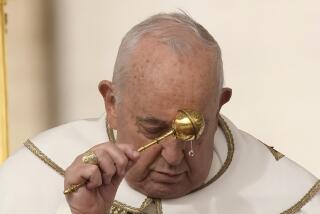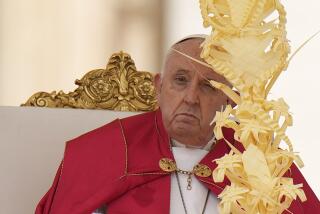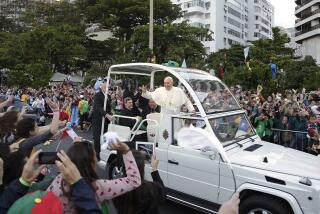The Celebrating Is Bittersweet on John Paulâs 25th Anniversary
VATICAN CITY â Pope John Paul II, the third-longest-serving pontiff in modern times, marked his 25th anniversary in power Thursday with an open-air Mass before the full hierarchy of the Roman Catholic Church and tens of thousands of pilgrims from all over the world.
In radiant golden vestments, his head tilted stiffly in pain, the 83-year-old pope thanked God and his followers for sustaining his remarkable tenure as leader of the church through a tumultuous quarter-century of change and conflict.
And as dusk fell on St. Peterâs Square, he prayed for the strength to continue, making it clear that he intended to do so despite the concerns about his health. Many who gathered here Thursday thought they might be saying goodbye.
âChrist, knowing of my human frailty, encourages me to respond with faith, like St. Peter ... and he invites me to take on the responsibilities that he has given me,â the pope said in his homily, which he began in a strong voice that tapered off as the night wore on.
The emotional ceremony was bittersweet: Celebration was sobered by the evidence of John Paulâs physical decline, which was a stark contrast to the youthful robustness of the Polish archbishop who took over the papacy in 1978. While the audience cheered, applauded and waved banners, many were also moved to tears.
John Paul, who now slumps in a chair and must be wheeled onto stage, is widely considered one of the most influential religious figures of modern history. He has transformed the papacy, evangelizing across the width and breadth of the planet. He has fought for human rights, spoken out against war and helped bring down communism.
He also centralized power at the Vatican and enforced a conservative church doctrine, one that many Catholics feel is out of touch with modern life.
As in most of his recent appearances, the pope, who suffers from Parkinsonâs disease, arthritis and other ailments, was unable to deliver his entire sermon. He read the first and last parts, leaving the midsection to an aide. His usually bright eyes appeared puffy; he was clearly moved at times, especially during an admiring speech by German Cardinal Joseph Ratzinger, one of his closest associates.
âI feel joy and sadness when I see him,â said Maria Teresa Tarrantino, 67, an Italian homemaker who was among the 50,000 or so people crowding into St. Peterâs Square -- and who was present 25 years ago on the evening that white smoke drifted from the Sistine Chapel to signify the selection of a new pope.
âWe were so proud of him, then and now,â said Tarrantino, dressed in a crisp white suit. âThis is why I came here. I donât know if God will take him away, or give him the strength to remain here with us. This could be the last time we can see him.â
That was a sentiment expressed over and over in the crowd, which had contingents from Belarus and Brazil, from John Paulâs native Poland and the United States.
âItâs sad to say, but thatâs how we feel,â said Debbie Kennedy of Summit, N.J. She and her husband, Tim, were in Rome to celebrate their wedding anniversary and then decided to attend Thursdayâs Mass. They said that even though the pope could not finish his speech, his message got across.
âItâs just his presence,â Tim Kennedy said. âHeâs saying donât lose faith, the church is still vibrant, itâs not just an artifact, you have to live it every day.â
In modern history, only two other popes served longer than John Paul: Pope Pius IX, who served 31 1/2 years until Feb. 7, 1878, and Pope Leo XIII, who served 25 years, four months and 17 days until July 20, 1903. St. Peter, the first pope, served the longest of all, at least 34 years, in the first years after Jesusâ death.
Earlier Thursday, John Paul issued a major document decrying the gulf between rich and poor, reminding clerics that they are to work to defend the weak and disenfranchised, and condemning the exploitation of religion for violent political ends.
The 192-page document sprang from a meeting of bishops two years ago and was seen as a road map for the church.
In it, the pope also ordered bishops to intervene âin a timely mannerâ to stop abuse or misdeeds by priests in their dioceses. This was a reference to the sexual abuse scandal that rocked the Catholic Church in the United States.
âIn cases of grave lapses, and even more of crimes which do damage to the very witness of the Gospel, especially when they involve the churchâs ministers, the bishop must be firm and decisive, just and impartial,â the pope wrote in the exhortation.
Events are not usually scheduled at night for John Paul, but Thursdayâs Mass was timed to coincide with the exact hour 25 years ago that his selection as the first non-Italian pontiff in 4 1/2 centuries was announced -- news that stunned the world.
The cardinals had gathered to name the successor to Pope John Paul I, who had died after barely a month in office. They deadlocked repeatedly; finally, on the eighth ballot at the end of the second day of debate, a winner emerged.
About 6:15 p.m. on Oct. 16, 1978, white smoke fluttered from the small chimney atop the Sistine Chapel. An announcement blurted over the loudspeaker to the thousands of people waiting in St. Peterâs Square. âIl fumo e bianco, e veramente bianco!â (The smoke is white, it is really white!)
Cardinal Pericle Felici stepped onto the balcony of St. Peterâs Basilica, a full moon hanging low over the Tiber River.
âHabemus papam,â he said in Latin. We have a pope.
There were cheers -- until he announced the name. No one knew who that was. An Asian? An African? the crowd asked.
Karol Wojtyla, whoâd had to hitchhike to the cardinals meeting because his car had broken down, emerged onto the balcony, and within minutes, as he asked the crowd to correct his Italian if he made any mistakes (he spoke it nearly perfectly), he had won their hearts.
The new Pope John Paul II invited them to join him âto start anew on this road of history.â
At Thursdayâs Mass, the elderly Pope John Paul II recalled the emotions of that day.
âHow could I, humanly speaking, not tremble?â he said. âHow could such a huge responsibility not weigh on me?â
In the end, he recalled, he gave his brother cardinals his response: âI accept.â
The debate over the popeâs legacy continues. Supporters say he is a uniquely charismatic leader who has revitalized the church. Critics say the church, losing ground against other religions in some parts of the world, is more divided than ever.
âDonât be fooled by the masses at big papal events,â Swiss-born theologian Hans Kueng, a longtime critic of the papacy, wrote in the weekly SonntagsZeitung. âDuring this papacy, millions have fled from the church or quietly turned inward.â
Kueng blames the exodus in part on the popeâs unyielding stands on contraception and the ordination of female priests. Others say his moral authority outweighs disagreement over specific issues.
âWhen my generation gets down on the church and thinks itâs floundering and attendance is down, itâs very encouraging to see the spirit of renewal he instills in the youth,â said Ray Flynn, former U.S. ambassador to the Vatican who attended Thursdayâs celebration.
More to Read
Sign up for Essential California
The most important California stories and recommendations in your inbox every morning.
You may occasionally receive promotional content from the Los Angeles Times.











